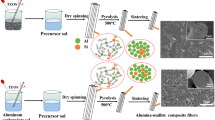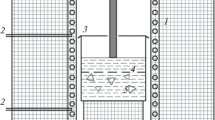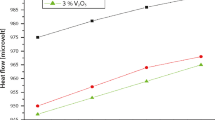Abstract
Mullite is an aluminosilicate widely used as a structural material for high temperature applications. This paper studies the effect of the gelation temperature on the synthesis of two mullite precursors: polymeric and colloidal silica, using both in fully-hydrolyzed silica sol, derived from sodium silicate. The gels were synthesized using aqueous silicic acid and aluminum nitrate. Ethylene glycol was added into polymeric gels. Two gelation temperatures were used: 80 and 100 °C. In the polymeric precursor, the increasing of the gelation temperature caused an increase in the silica incorporation inside the mullite crystalline lattice at 1,000 °C, and it also generated an increase in the reaction extent at all calcination temperatures. In the colloidal precursors, these effects were more intense than in the polymeric precursors in terms of yield. Colloidal samples calcined at 1,250 °C crystallized cristobalite and alpha alumina in addition to mullite when they were previously gelled at 80 °C. On the other hand, the same sample gelled at 100 °C led to only crystallized mullite. The reaction extent increased by more than 20 % for colloidal samples gelled at 100 °C compared to colloidal samples gelled at 80 °C (calcined at 1,250 °C). This increase was due to the almost total incorporation of alumina and silica in the crystalline lattice of mullite.






Similar content being viewed by others
References
Rüscher CH, Schrader G, Götte M (1996) Infra-red spectroscopic investigation in the mullite field of composition: Al2(Al2 + 2xSi2 − 2x)O10 − x with 0·55 > x > 0·25. J Eur Ceram Soc 16:169–175
Cividanes LS, Campos TMB, Rodrigues LA et al (2010) Review of mullite synthesis routes by sol–gel method. J Sol Gel Sci Technol 55:111–125
Schneider H, Schreuer J, Hildmann B (2008) Structure and properties of mullite—a review. J Eur Ceram Soc 28:329–344
Cividanes LS, Brunelli DD, Bertran CA et al (2011) Urea effect on the mechanism of mullite crystallization. J Mater Sci 46:7384–7392
Chakraborty AK (2008) Si-incorporated alumina phases formed out of diphasic mullite gels. J Mater Sci 43:5313–5324
Rodrigues LA, Campos TMB, Alvarez-Mendes MO et al (2012) Phenol removal from aqueous solution by carbon xerogel. J Sol Gel Sci Technol 63:202–210
Fernandes FW, Campos TMB, Cividanes LS et al (2013) Influence of ethylene glycol on the mullite crystallization processes analyzed by rietveld refinement. J Aerosp Technol Manag 5:431–438
Almeida FA, Botelho EC, Melo FCL et al (2009) Influence of cassava starch content and sintering temperature on the alumina consolidation technique. J Eur Ceram Soc 29:1587–1594
Cividanes LS, Campos TMB, Bertran CA et al (2010) Effect of urea on the mullite crystallization. J Non Cryst Solids 356:3013–3018
Mizukami F, Maeda K, Toba M et al (1997) Effect of organic ligands used in sol-gel process on the formation of mullite. J Sol Gel Sci Technol 8:101–106
Campos TMB, Cividanes LS, Brunelli DD et al (2012) Effect of ethylene glycol on the mullite crystallization. J Eur Ceram Soc 32:835–842
Mazza D, Ronchetti S, Costanzo A (2008) Atomistic simulations on mullite Al2(Al2 + 2xSi2 − 2x)O10 − x in a variable range of composition. J Eur Ceram Soc 28:367–370
Voll D, Angerer P, Beran A, Schneider H (2002) A new assignment of IR vibrational modes in mullite. Vib Spectrosc 30:237–243
Okada K, Aoki C, Ban T et al (1996) Effect of aging temperature on the structure of mullite precursor prepared from tetraethoxysilane and aluminum nitrate in ethanol solution. J Eur Ceram Soc 16:149–153
Chen X, Gu L (2008) The sol–gel transition of mullite spinning solution in relation to the formation of ceramic fibers. J Sol Gel Sci Technol 46:23–32
Fischer RX, Vollb D (1996) Formation of aluminum rich 9: 1 mullite and its transformation to low alumina mullite upon heating. J Eur Ceram Soc 16:109–113
Kleebe H-J, Siegelin F, Straubinger T, Ziegler G (2001) Conversion of Al2O3–SiO2 powder mixtures to 3:2 mullite following the stable or metastable phase diagram. J Eur Ceram Soc 21:2521–2533
Yabuki M, Takahashi R, Sato S et al (2002) Silica-alumina catalysts prepared in sol-gel process of TEOS with organic additives. Phys Chem Chem Phys 4:4830–4837
Douy A, Coutures JP, Scientifique R (1996) Characterization of mono- and diphasic mullite precursor powders prepared by aqueous routes. TAI and 29Si IVIAS-NIVIR spectroscopy investigations. J Mater 31:4581–4589
Leivo J, Linden M, Rosenho LMJ et al (2008) Evolution of aluminosilicate structure and mullite crystallization from homogeneous nanoparticulate sol–gel precursor with organic additives. J Eur Ceram Soc 28:1749–1762
Gerardin C, Sundaresan S, Benziger J, Navrotsky A (1994) Structural investigation and energetics of mullite formation from sol–gel precursors. Chem Mater 6:160–170
Chen X, Gu L (2009) Structural evolution of sol–gel derived mullite fibers with different solid contents during sintering. J Mater Process Technol 209:3991–3998
Author information
Authors and Affiliations
Corresponding author
Rights and permissions
About this article
Cite this article
Campos, T.M.B., Cividanes, L.S., Machado, J.P.B. et al. Mullite crystallization using fully hydrolyzed silica sol: the gelation temperature influence. J Sol-Gel Sci Technol 72, 219–226 (2014). https://doi.org/10.1007/s10971-014-3285-9
Received:
Accepted:
Published:
Issue Date:
DOI: https://doi.org/10.1007/s10971-014-3285-9




